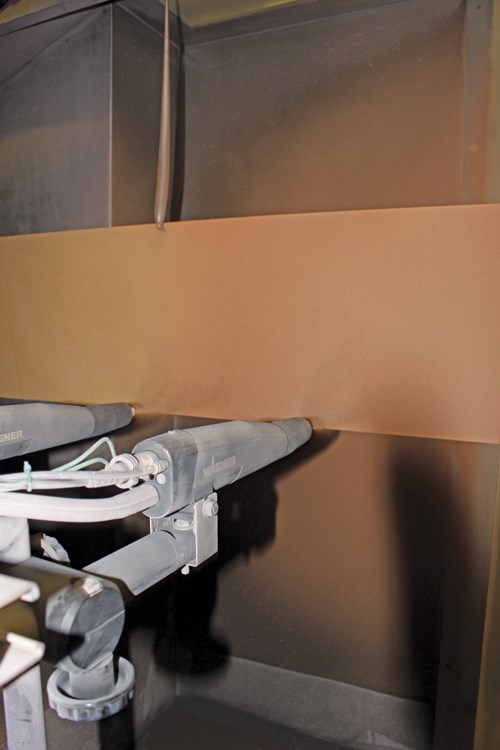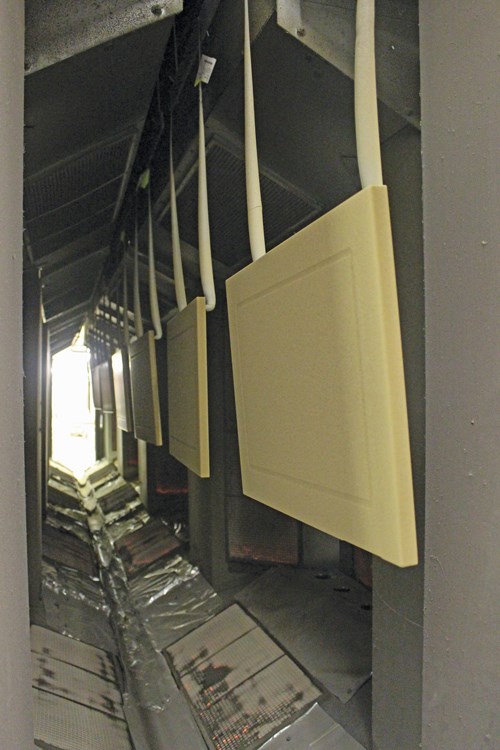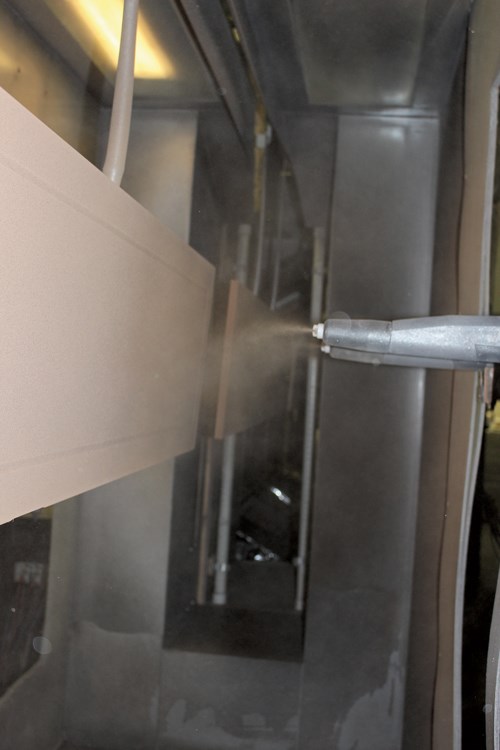Powder Coat MDF for an Enviable Finished Product
Cabinet maker says powder coating on wood offers more benefits.
#curing #masking #basics
Like many small businesses, we started in a two-car garage. That was 1985. To date, we have supplied general contractors with casework for schools and hospitals, produced hundreds of kitchens for high-end condos and time-share projects, and have custom manufactured thousands of components and powder-coated parts to OEMs and store fixture shops.
In addition, we have two cabinet component lines of our own, Redline Garagegear and Redline Closet Systems, where we provide distinctive and durable powder-coated doors and drawer fronts.
Featured Content
When it comes to coating medium-density fiberboard (MDF), we are often asked about the big difference between powder coating and conventional liquid paint. Most folks are also interested in learning more about the benefits of powder coating, many of which are not available with other finishes.
MDF is a wood material made from various wood fibers. It is produced by combining the wood fibers with a resin, high temperatures and pressure. Finishing wood with powder is becoming increasingly popular because of the many advantages it offers to manufacturers and consumers alike. For one, the powder is dry and does not require any solvents. The process of powder coating on MDF is quite different from applying a liquid paint.

After years of research coupled with trial and error, researchers found that medium density fiberboard (MDF) is the best material for powder coating.
Two Types of Powder Coating
There are two types of powder that can be applied to wood products: thermoplastic and thermoset. Thermoplastic powders are applied to a surface that has already been heated. Usually, the preheating temperature is the exact temperature for melting the thermoplastic powder.
Another common question that people ask when learning about powder-coated wood: So how do you get the powder to stick to the wood?
That is a really good question. A powder finish is very different from liquid paint because it is applied as a solid rather than in liquid form. As a solid, there are no solvents, hazardous air pollutants (HAPs) or volatile organic compounds (VOCs). It is safe for people, animals, and the environment while providing a durable layer of protection to the wood.
Three factors contribute to getting the powder to stick: the wood itself, the heat applied and the powder charge.
Picking the Right Wood – This is probably the cornerstone of the entire process. We have very specific criteria that wood board must meet before we can use it to manufacture parts for powder coating.
After years of research coupled with trial and error, researchers found that medium-density fiberboard (MDF) is the best material for powder coating. MDF is an engineered board consisting of various mixed and compressed wood fibers, adhesives and resins. An MDF board has a surface that is not as porous as other woods and is also uniform.
We know what type of wood needs to be used for powder coating, but it does not stop there. The MDF boards still need to meet our established standards before they make the cut. Part of the process involves rapidly heating and cooling the MDF board. A particular board must have internal bond strength of 130 pounds per square inch in order to withstand that part of the process.
Another important requirement of the MDF boards we use is that they have five to seven percent moisture content. That moisture will be used to render the board conductive.

MDF board is heated to a very high temperature very quickly in order to draw the moisture to the surface and make it conductive.
Applying Heat
One of the first parts of the powder coating process is enabling the MDF board to conduct an electric current. This is why having a five to seven percent moisture content is important. The board is heated to a very high temperature very quickly in order to draw the moisture to the surface and make it conductive. After being sprayed, the board is again heated so that the powder will gel, flow, and bond to the wood. As it flows, the powder wraps around the edges of the part, creating a smooth and seamless finish. Because of this, we are able to coat a large variety of irregular and odd-shaped parts.
There are currently three types of ovens being used to heat wood surfaces. UV and convection ovens are both options used by various manufacturers to get the wood to the correct temperature. GCC Coatings uses infrared catalytic ovens for both the preheat and gel portions of the process to heat the surface of the MDF boards. Our infrared ovens are able to get the wood to the optimal temperature for applying the powder without compromising the integrity of the wood.
Charging the Powder
Finally, we arrive to the last factor necessary in getting the powder to stick to the wood. I suppose you could say that this is where the magic happens. Once the MDF has been heated and is able to conduct an electrical current, it is ready for powder coating.
For an accurate and consistent finish, GCC Coatings uses automatic sprayers capable of imparting a negative charge to the powder as it is being pushed out of the tip of the sprayer with compressed air. That negative charge makes the powder particles electrostatic, quickly drawing them to the grounded part. (The charge plays a role in helping us reclaim as much as 98 percent of the powder overspray as well.) Another round of heating will cause the powder to permanently bond to the surface of the wood.
It is an intricate process, requiring all of the necessary parts and pieces to be in place for the best results. Our clients and customers are very pleased with the quality and durability of the powder-coated wood parts we manufacture for them.

Seven Benefits
There are many benefits to powder-coated MDF. A powder finish offers the advantages of both protection and style to consumers. Powder coating makes the wood products resistant to stains and damage caused by direct sunlight, and the MDF is protected from scratches, rough handling, chemical or water spills, and temperature extremes.
And color options for powder coating are nearly unlimited, giving designers ultimate flexibility. So let’s get into the seven main benefits of powder coating wood.
1. Durability – One of the greatest benefits of powder coating is the added durability it gives to the coated part. A powder-coated wood part will be resistant to most chemicals, moisture, heat and minor scratches. It has outlasted its laminate, melamine and liquid paint counterparts in both chemical and physical testing. Chemical tests found that alcohol, household detergents, ink, gas and graphite have little to no effect on a powdered part. Our sister company, RedLine Garagegear, produces powder-coated wood garage cabinets. For nearly a decade now, those garage storage systems have been installed in garages throughout the U.S. and Canada. The cabinets are designed and built to last a lifetime, and are fully capable of withstanding extreme temperatures, spills and a little rough handling.
2. Versatile Design –We often discuss with customers how the powder gels, bonds, and flows to the surface of the wood when heated. Because the powder flows, it is easier to create an even finish on shaped and contoured parts. This gives product and display designers freedom to create without worrying about coating limitations.
3. Environmentally Friendly Manufacturing – There are a number of things that make powder coating an environmentally friendly practice. First, we are able to reclaim up to 98 percent of the overspray. So any powder that does not make it onto the board can be saved and used for the next project. It’s rare for powder to ever end up in a landfill. Second, there are no VOCs, HAPs or heavy metals. Operators don’t have to worry about breathing in any harmful stuff because powder-coated wood does not emit any of that pollution. Third, catalytic infrared ovens are very energy efficient. Lastly, the wood used for powder coating, MDF, is made of recycled wood fibers. A typical MDF board will not contain any formaldehyde resins, bringing it in line with the California Air Research Board (CARB) regulations on formaldehyde in engineered wood.
4. Cost-effective Manufacturing – A couple of the factors that make this manufacturing process environmentally friendly also make it cost-effective. The ability to recycle so much of the overspray greatly benefits the bottom line for clients. Using energy-efficient ovens is also a cost saver. The cost of capital investments in powder coat equipment is quite competitive. GCC has developed a continuous, automatic and streamlined single coat process that moves the parts seamlessly from one station to the next, a process that saves time while also significantly reducing human error.
5. Effects and Colors – This process enables offering a variety of textures and colors to clients, including hammer tones, a matte smooth finish, a glossy finish, or a micro-texture and a nearly endless number of custom colors. It is also important to note that a powder coated part will show less appearance difference between vertically and horizontally coated surfaces. Powder finishes can also provide a thicker coating without the sagging or runny effect produced when a thick coat of liquid paint is applied to a substrate.
6. Branding Powder-coated Wood – Something you will consider even before deciding on a finish is how you will brand your product. There are several ways to effectively brand powder-coated wood parts before packaging it for the end user. Ink transfers, digital printing, screen printing, vinyl printing and domed tags are some of the branding options available.
7. Antimicrobial Coatings – GCC Coatings offers an antimicrobial additive that can be added to the powder when it is being made. The result is a surface that is capable of killing germs on contact. The additive that we are using is made of inorganic compounds which will also prevent any further bacterial growth. This is an especially ideal solution for schools, food preparation areas and medical facilities (i.e., hospitals, nursing homes, etc.).
Troy Greenberg is president of Greenberg Custom Cabinets and GCC Coatings in South Beloit, Ilinois. For more information, visit powdercoatmdf.com
RELATED CONTENT
-
Dis-Charge Your Powder
A practical approach to managing electrostatic problems and hazards during powder coating
-
Understanding Infrared Curing
Infrared cure is gaining increased attention from coaters as a result of shorter cure cycles and the possibility of smaller floor space requirements when compared to convection oven curing.
-
Curing Oven Basics
Simply heating up the substrate does not cure the coating. There are many variables to consider when choosing the best cure oven for your application...


















